Another year, another temperature record broken, with cities across the world scorching under the blazing sun. If you’ve noticed that urban life feels much hotter than your summer jaunts to the seaside or the mountains, you’re not imagining it.
Urban areas are much hotter than rural areas, to the tune of at least 1–3 °C (1.8–5.4 °F) depending on location. This is due to the Urban Heat Island effect. Buildings, roads, and pavements are less reflective than, say, large water bodies like lakes, and the dark, dense construction materials absorb more heat and radiation from the sun’s rays. They trap heat more effectively than plants and are poor at releasing or dispersing it. Concrete streets are much worse for evaporation, so there’s no moisture to help take away the heat.
There are more people in cities, generating more heat in general, and their inhabitants’ activity—air conditioning for instance—only leads to more heat being pumped out into the streets, where it has nowhere to go. Convection, normally so effective at dissipating heat, is much less effective in cities, partly because the smooth surfaces of roads and buildings reduce air turbulence that helps release heat from the surface to the atmosphere. Instead, the hot air gets caught up in the urban canyons formed between buildings.
In cities, the heat feels especially brutal at night. In the countryside, night is a relief, because the environment releases pent up heat back into the atmosphere. Not in the city. As far back as 1972, scientists noted differences of 4–7 °C hotter than rural areas, creating constant heat stress on cities and their inhabitants. As the Guardian reported:
One study of an intense 2008 heat wave in Oklahoma found that Oklahoma City’s temperatures were, on average, 1 °F (Fahrenheit) warmer during the day and 4°F warmer at night than surrounding areas. That may not seem like a lot, but heat stroke occurs when the body temperature rises to 105 °F, so the difference between 102 °F and 106 °F can be critical.
A 2014 study found that at night, the bigger the city, the greater difference in temperature compared to areas outside the city limits. As the Smithsonian explains, “heat gets trapped in the shallow layer of atmosphere near the surface, and to dissipate, it has to move more horizontally to escape. For bigger cities, the heat will have to move farther, so the center of a big city will tend to be much warmer than the middle of a small city.”
Increasing the reflectiveness of a building—painting roofs white, for instance—can be a cheap, easy, and effective solution, reducing the amount of heat absorbed and released after hours. Such solutions are particularly important to powering the global economy, whose heat-exposed workers lose productivity as temperatures continue to rise.
We at Quartz are insatiably curious. We bring you the best timely research in science and technology, but in Funny you should ask, we’ll tackle timeless questions. If you have some, submit them here.
